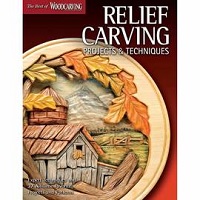CHAPTER XXV
SURFACE FINISH - TEXTURE
Tool Marks, the Importance of their Direction - The Woody Texture Dependent upon Clearness of Cutting and Sympathetic Handling.

CLICK HERE CLICK HERE The word "texture" is sometimes applied to the quality of the finish which is characteristic of good wood carving. However it can be somewhat misleading. It seems to suggest that the final treatment of the surface is the result of a separate operation, or process.
However, it is a valid description, as the texture which wood-carvers strive for is the true feel of the wood in which they are carving. You might naturally think that this texture just has to appear when the work was finished, but that isn't always the case, as it is actually the result of the most skillful use of the tools, and easily disappears due to clumsy work or the ministrations of unsympathetic hands.
Texture in carving is in some respects on a parallel with tone in painting—it depends upon a right relation of many qualities.
As in painting, good tone [235] is the outcome of the combined effects of truth in color and a right balance of what are called the "values," together with decision in the handling of the brush, so in carving, texture depends upon, first, having a clear idea of what is being carved, and making it clear to others; that if it be round, hollow, or flat, it must be so indeed; that edges and sharpnesses be really where they were intended to be, and not lost in woolly confusion. Then again, as with the painter's brush, the tool must be moved by a hand which adapts itself to every changing plane, to all manner of curves and contours, with touches sometimes delicate and deliberate, at others broad and sweeping, or even, at times, brought down with the weight and force of an ax-blow.
A good quality of finish may exist in the most divergent kinds of work, each having its own characteristic texture. Thus a broad treatment on a large scale will make much of the natural texture of the wood, enforcing it by crisp edges and subtle little ridges which catch the light and recall the momentary passage of the sharp tool, while elaborate work in low relief may have a delicate texture which partly imitates that of the details [236] of its subject, and partly displays the nature of the wood. In either case, the texture must be consciously aimed at by the carver as the last but by no means least quality which is to give vitality to the work of his hands. A sense of the capabilities of his wood in this respect is one of the best aids to the carver, as it reacts on his sense of form and compels him to precision.
Manual dexterity alone may succeed in making its work clearly intelligible, but that is all, and it generally leaves a surface in which there is little indication of any feeling for the material in which the work is carved, nothing, in fact, that marks it specially as carving in wood, or distinguishes it from a casting in metal.
The technical operation which is most immediately answerable for the making or marring of texture is the disposition and nature of the final tool marks. These should be so managed that they help the eye to understand the forms. They should explain rather than confuse the contours of the surface. Just as in a good chalk drawing the strokes and cross-hatchings are put in with method, and if well done [237] produce the effect of something solid, so in carving, the tool marks should emphasize the drawing without in any way calling attention to themselves.
It is quite impossible to explain in words that will not be open to misconstruction the subtle commingling of qualities which make all the difference between good and bad texture. We may succeed better by describing those conditions which are unfavorable to it. Thus work which is very much cut up into minute detail, and which lacks a proper contrast of surface, or, for the same reason, work which is too generally bald and smooth, rarely exhibit a good surface texture. Again, work which is overlabored, or where delicate details have been attempted on a coarse-grained wood, or finally, work which, although done with success in the matter of mechanical dexterity, is deficient in feeling for its woody possibilities, are all likely to fail in the matter of texture.
Punch-marked backgrounds have undoubtedly a legitimate place among the expedients of the carver for obtaining contrast, but on the whole, as such, they are of a somewhat meretricious order, and [238] in almost every case their use is fatal to the charm of fine texture, as this always depends on an appreciation of the homogeneous connection of carving and background. If they are used at all they should be made to form patterns on the background, and not put down promiscuously. Little gouge marks are still better, as they are not so mechanical.
I shall conclude this part of my subject with a quotation from the words of Mr. W[illiam]. Aumonier, in a lecture delivered at the Royal Institute of British Architects.
"All carving to be treated according to the position it is to occupy. Not only the design, but the actual carving itself, should be considered with a view to the position it is to take and the light it will receive. Thus, even if quite close to the eye, where, of course, its position warrants or demands a certain amount of finish, it must be remembered that real finish rather means perfection of form than smoothness of surface, so that even there it should still show its cuts and its tool marks fearlessly, and be deepened in parts to make it tell its proper tale in the combined scheme of decoration; while if it is going a great height or distance from the eye it should [239] be left as rough as ever you can leave it. The only points that have to be regarded are the outlines, varieties of planes, and depths, and if these be properly considered everything else will take care of itself, and then the whole work can not be left too rough. Its very roughness and choppy cuts will give it a softness and quality when in its place that no amount of smoothing or high finish can possibly attain to."
Beware of putting a wrong interpretation upon the word "rough" - refer to what he says of the points to be regarded, i.e., the "varieties of planes, and depths." If they are right the "roughness" is not likely to be of the offensive kind.
Nothing so effectually destroys the quality of texture as polish applied to carving.
If furniture must be polished it should not be carved. The only polish that improves carving is that which comes of use. On hard woods, such as oak or Italian walnut, the pressure of the tools leaves a pleasant polish, which is all that is necessary; the most that should be allowed may be given by a little burnishing with the handle of the tool. [240]

|
INFORMATION ABOUT HOW TO MAKE MONEY FROM WOOD CARVING |

